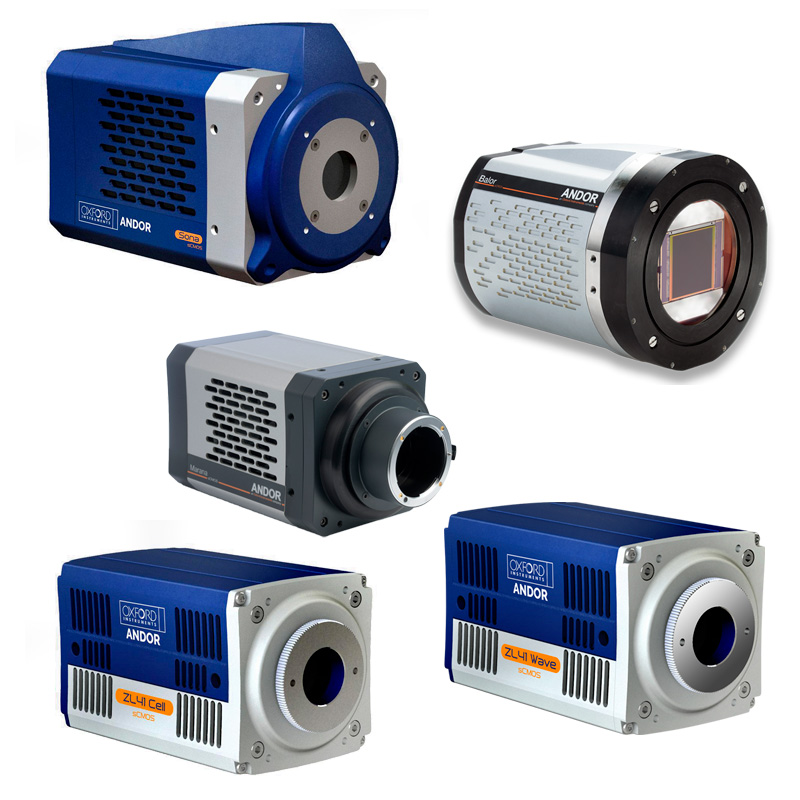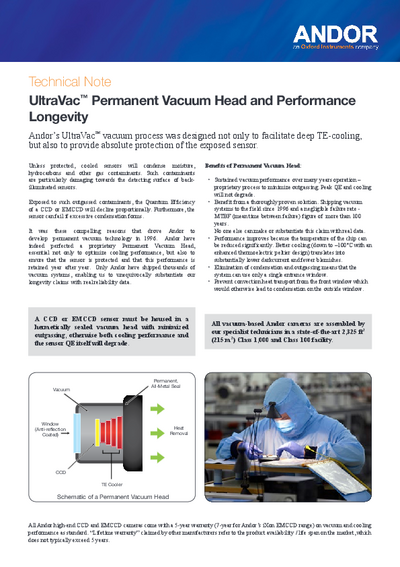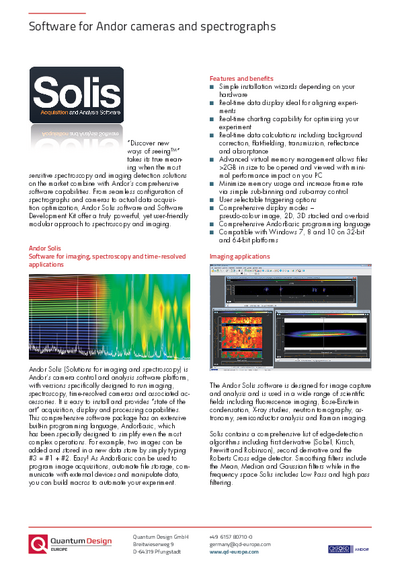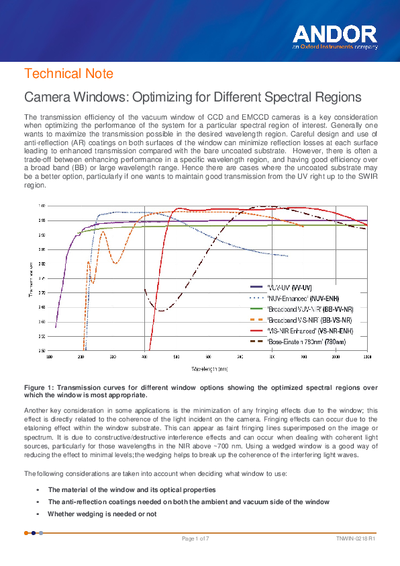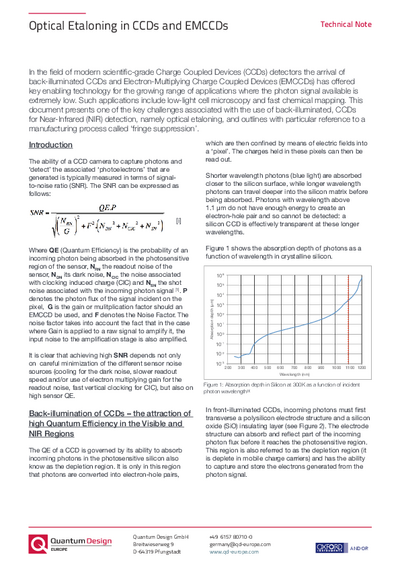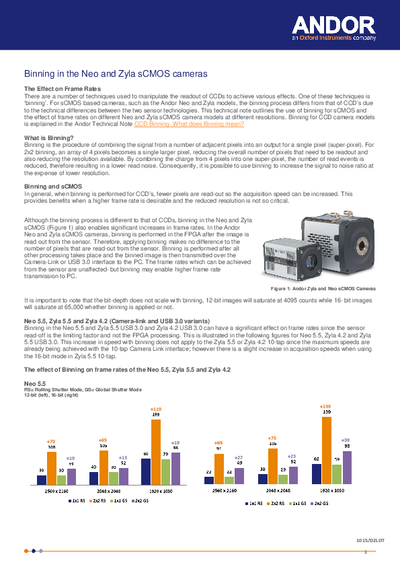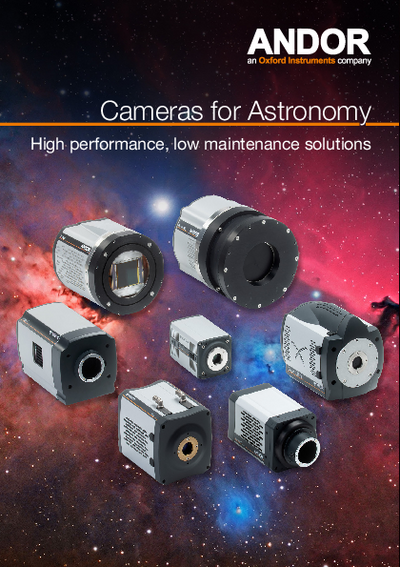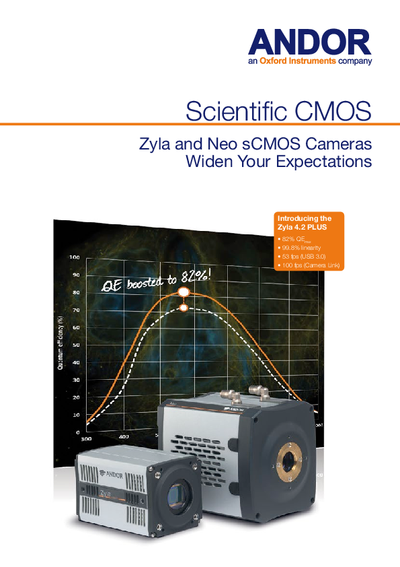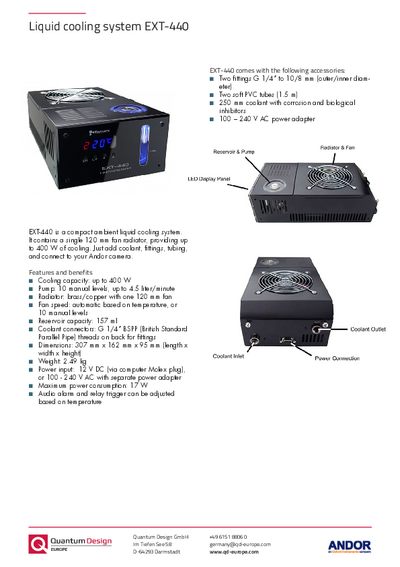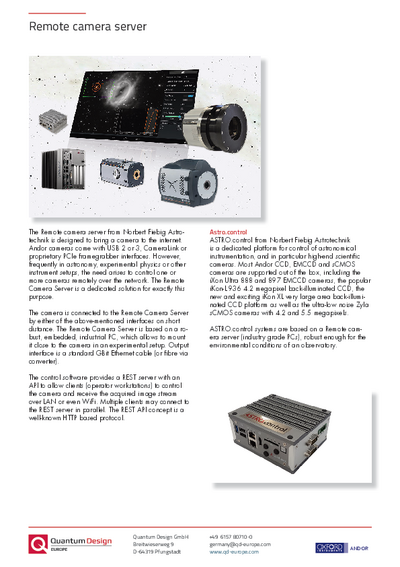Camere sCMOS
Balor, Marana, Sona, Zyla e ZL41 da Oxford Instruments AndorLe camere Andor serie Balor, Marana, Sona e ZL41 si basano sullo sviluppo della ben nota tecnologia CMOS e sono dotate di sensori di ultima generazione per applicazioni scientifiche. Grazie alle loro particolari proprietà tecniche, le camere sCMOS Andor rappresentano un sistema di acquisizione dalle alte prestazioni adatto alle più impegnative applicazioni per la misura quantitativa nel campo della Fisica, dell’Astronomia e della Biologia.
Poiché tutte le camere sCMOS Andor sono caratterizzate da elevata sensibilità e rumore estremamente basso, queste sono spesso in grado di generare immagini di qualità superiore a quelle ottenibili con camere EMCCD, anche in condizioni con basso livello di luce.
Il sensore delle camere Marana, Sona e Balor si trova, inoltre, all’interno di un enclosure in condizioni di vuoto e può essere raffreddato fino ad una temperatura di -40 °C e -30 °C rispettivamente, attraverso sistema termoelettrico. Il basso valore di dark current che ne deriva rende le camere Marana, Sona e Balor compatibili anche con applicazioni caratterizzate da requisiti particolarmente stringenti.
Oltre al tipico utilizzo nel campo dell’imaging, le camere sCMOS Marana e ZL41 trovano largo impiego anche nel settore della Spettroscopia veloce, specialmente in applicazioni di Spettroscopia multi-track e di imaging iperspettrale.
- Read Noise: 0.9 e- (detection limit inferiore a qualsiasi camera CCD)
- Efficienza Quantica fino al 95%
- Sensori da 2.0, 4.2 e 5.5 Mpixels con pixel size di 6.5 µm e 11 µm
- Frame rate fino a 101 frames/s in continua ed in full resolution
- Range dinamico fino a 53.000 : 1
Maggiori informazioni
Le camere Andor sCMOS serie Balor, Marana, Sona e ZL41 offrono le massime prestazioni di imaging in termini di elevata sensibilità, alta risoluzione, rapido frame rate ed ampio campo di vista, in un’unica piattaforma. Raffreddate tramite sistema termoelettrico sono inoltre caratterizzate da un design estremamente compatto e leggero perfettamente integrabile sia in setup di applicazioni industriali che di Ricerca scientifica.
Le camere sCMOS Balor, Marana e Sona, dotate di intelligenza FPGA e con sensore in condizioni di vuoto e raffreddato termo-elettricamente, sono progettate per garantire la più alta sensibilità possibile ottenibile da questo interessante ed innovativo sviluppo tecnologico. A differenza di qualsiasi altra precedente tecnologia CMOS o CCD, le camere sCMOS Andor Balor, Marana, Sona e ZL41 offrono infatti la possibilità di fare Imaging scientifico senza compromessi sfruttando contemporaneamente le più alte prestazioni in termini di sensibilità, risoluzione, velocità di acquisizione, range dinamico e campo di vista.
Basata su un nuovo e unico sensore da 16.9 megapixel, la Balor è una camera sCMOS rivoluzionaria specialmente per l'astronomia, con un ampio field of view ed una lettura eccezionalmente veloce: 18.5 ms. La camera Balor è in grado di acquisire fino a 54 frames al secondo a risoluzione completa, mantenendo un rumore di lettura molto basso, <3 elettroni. I pixel da 12 µm garantiscono un ampio well depth ed il design con multi-amplificatori on-chip permette che l'intero range fotometrico, dal rumore di base fino al limite di saturazione, possa essere catturato con un'immagine, caratteristica ideale per la quantificazione attraverso un range di intensità. Il sensore da 16.9 megapixel della Balor, con una dimensione di 49.5 mm x 49.2 mm, offre il più ampio filed of view di qualsiasi camera sCMOS sul mercato.
Le camere Marana e Sona sono dotate di sensori sCMOS back-illuminated con 4.2 o 2.0 megapixel ed un valore di efficienza quantica pari al 95%, il più alto disponibile. Il sensore ottimizzato per il range UV offre la massima sensibilità da 250 nm a 400 nm.
La ZL41 rappresenta la soluzione ideale per tutti i setup sperimentali in cui viene richiesta elevata sensibilità combinata ad alta velocità di acquisizione, offrendo frame rate fino a 101 fps con interfaccia CameraLink - od anche superiori in modalità sub-windowing - e valori di read noise fino a 0.9 elettroni.
L'esclusiva tecnologia adottata per la soppressione del dark noise garantisce, inoltre, il mantenimento di un basso livello di rumore al variare delle condizioni di esposizione. L'interfaccia "plug and play" USB 3.0 offre prestazioni di frame rate leader del settore, fino a 53 frame/s con una risoluzione di 4.2 Mpixels.
L’impareggiabile flessibilità di impiego e le elevate prestazioni offerte in ogni condizione sperimentale dalle camere sCMOS ZL41 ridefiniscono il concetto di camera ‘general purpose’ e ne estendono il campo applicativo andando rapidamente a sostituire le camere con sensori CCD interlinea.
L’implementazione di entrambe le modalità di readout, Rolling e Global Shutter (snapshot), garantisce la massima flessibilità di impiego per le camere sCMOS Neo e Zyla con sensore da 5.5 Mpixels; il Global Shutter Mode, in particolare, permette alla camera di acquisire un ‘freeze frame’ emulando la modalità di acquisizione caratteristica delle camere CCD interlinea frame transfer.
Specifiche
Panoramica delle specifiche chiave:
| Balor | Marana 4.2B-11 | Marana 4.2B-6 | Sona 4.2B-11 | Sona 2.0B-11 | Sona 4.2B-6 | ZL41 Cell 5.5 | ZL41 Cell 4.2 | |
| Resolution | 4128 x 4104 x 12 µm | 2048 x 2048 x 11 µm | 2048 x 2048 x 6.5 µm | 2048 x 2048 x 11 µm | 1400 x 1400 x 11 µm | 2048 x 2048 x 6.5 µm | 2560 x 2160 x 6.5 µm | 2048 x 2048 x 6.5 µm |
| Sensor Diagonal | 70 mm | 31.9. mm | 18.8 mm | 31.9 mm | 21.8 mm | 18.8 mm | 21.8 mm | 18.8 mm |
| Quantum Efficiency | 61 % | 95% | 94 % | 95% | 95% | 94 % | 64% | 82% |
| Read Noise | 2.9 e- | 1.6 e- | 1.1 e- | 1.6 e- | 1.6 e- | 1.2 e- | 0.9 e- | 0.9 e- |
| Sensor Temperature | -30 °C | -45 °C | -45 °C | -45 °C | -45 °C | -45 °C | 0° C or -10 °C | -10 °C / 0° C |
| Dark Current | 0.065 e-/pixel/s | 0.3 e-/pixel/s | 0.1 e-/pixel/s | 0.3 e-/pixel/s | 0.3 e-/pixel/s | 0.1 e-/pixel/s | 0.1 or 0.019 e-/pixel/s | 0.1 or 0.019 e-/pixel/s |
| Cooling | air and water or water only | air and water | air and water | air and water | air and water | air and water | air or water | air or water |
| Dynamic Range | 27,586 : 1 | 53,000 : 1 | 36,667 : 1 | 53,000 : 1 | 53,000 : 1 | 34,000 : 1 | 33,000 : 1 | 33,000 : 1 |
| Linearity | >99.7 % | >99.7 % | >99.7 % | >99.7 % | >99.7 % | >99.7 % | >99.8 % | >99.8 % |
| PRNU (Photon Response Non-Uniformity) | <0.5 % | <0.5 % | <0.5 % | <0.5 % | <0.5 % | <0.5 % | <0.01 % | <0.01 % |
| Shutter | Rolling and Global | Rolling | Rolling | Rolling | Rolling | Rolling | Rolling and Global | Rolling |
| Interface | CoaXPress (4 lane CXP-6) | USB 3.0 | USB 3.0 / CoaXPress | USB 3.0 | USB 3.0 | USB 3.0 / CoaXPress | USB 3.0 or 10-tap CameraLink | USB 3.0 or 10-tap CameraLink |
| Full Frame Rate | 54 | 48 | 43 / 74 | 48 | 70 | 43 / 74 | 40 or 100 | 53 or 101 |
Applicazioni
Downloads
Video
Opinioni degli utenti
| Title | Author(s) | Institute | Year | Spectrograph/ Detector |
|---|---|---|---|---|
| Microsopy | ||||
| Microscopy of LEDs and phosphors in practical exercises for students | S. Bock, D. Berben | Department of Electrical Engineering and Information Technology, South Westphalia University of Applied Sciences, Hagen, Germany | 2017 | Neo-5.5-CL3 |
| Fluorescence microscopy of semiconductor nanowire arrays | S. Rahimzadeh-Kalaleh Rodriguez1, D. van Dam2, J. Gomez Rivas1,2 | 1Surface Photonics, AMOLF, c/o Philips Research Laboratories, Eindhoven, The Netherlands 2COBRA Research Institute, Eindhoven University of Technology, The Netherlands | 2014 | Neo DC152 QC-FI1 |
| Detection of electrochemically generated peroxide and superoxide by fluorescence microscopy | C. Dosche, S. Dongmo | Institute of Chemistry, University of Oldenburg, Germany | 2013 | Neo DC152 QC-FI1 |
| Imaging with scintillation screens | ||||
| Phase transitions in 1T-TaS2 mapped by ultrafast LEED | S. Vogelgesang, G. Storeck, S. Schäfer, C. Ropers | IV. Physical Institute, Georg-August-University, Göttingen, Germany | 2017 | Zyla-5.5-CL10 |
| Application of the sCMOS camera Andor Neo for X-ray and neutron imaging | N. Kardjilov1, S. Williams1,2, F. Wieder1, A. Hilger1, I. Manke1 | 1Helmholtz-Zentrum-Berlin, Berlin, Germany 2Johns Hopkins University, Baltimore, USA | 2014 | Neo DC152-QF-FI3 |
| Polarization dependent photoelectron emission with high lateral resolution | T. Wagner | Institute of Experimental Physics, University of Linz, Austria | 2012 | Neo DC152-QC-FI1 |
| Plasma- and fusion research | ||||
| Evaluation of the Zyla sCMOS imaging camera for IMSE diagnostic | O. P. Ford, C. Biedermann | Wendelstein 7-X, Max Planck Institute for Plasma Physics, Greifswald, Germany | 2014 | Zyla-5.5-CL10 |
| Measuring ion temperatures and helium densities in the hot core of a nuclear fusion reactor using sCMOS and EMCCD cameras | R. J. E. Jaspers | Department of Applied Physics, Eindhoven University of Technology, The Netherlands | 2014 | Neo DC152 QC-FI1 |
| Real-time characterization of plasma evolution by diffraction imaging | N. K. Rothe, A. V. Svanidze, C. Schuster, M. Lütgens, S. Lochbrunner | Institute of Physics, University of Rostock, Germany | 2013 | Neo DC152 QC-FI1 |
| Astronomy | ||||
| High-speed imaging and its applications: Beating down the scintillation noise | P. Ioannidis, J.H.M.M. Schmitt | Hamburg Observatory, Physics Department, University of Hamburg, Germany | 2017 | Zyla-4.2-CL10 Neo-5.5-CL3 |
| Active optical debris detection: Highly accurate position determination of space debris orbits | W. Riede, D. Hampf, P. Wagner, L. Humbert, F. Sproll, A. Giesen, | Institute of Technical Physics, Deutsches Zentrum für Luft- und Raumfahrt (DLR), Stuttgart, Germany | 2016 | Zyla-5.5-CL10 |
| Quantum physics | ||||
| Real- and momentum-space imaging of plasmonic waveguide arrays | F. Bleckmann, S. Linden | Physikalisches Institut, Rheinische Friedrich-Wilhelms-Universität Bonn, Germany | 2016 | Zyla-5.5-USB3 |
| Particle image velocimetry (PIV) and particle tracking velocimetry (PTV) | ||||
| Redesign of a 3D PTV system with ANDOR’s Neo sCMOS | P. Steinhoff, M. Schmidt, D. Müller | E.ON Energy Research Center, Institute for Energy Efficient Buildings and Indoor Climate (EBC), RWTH Aachen University, Germany | 2013 | Neo DC152 QFR-FI2 |
| Spectroscopy | ||||
| Photoluminescence spectroscopy of metal nanoantennas coupled to the atomically thin semiconductor WS2 | J. Kern, R. Bratschitsch | Institute of Physics and Center for Nanotechnology, University of Münster, Germany | 2015 | Neo-5.5-CL3 |
| Using a surface-forces-apparatus to measure force-distance profiles across confined ionic liquids | T. Utzig, H.-W. Cheng, M. Valtiner | Department of Interface Chemistry and Surface Engineering, Max-Planck-Institut für Eisenforschung, Düsseldorf, Germany | 2014 | Zyla-5.5-CL3 |
Remarks:
1New part number of DC152 QC-FI: Neo-5.5-CL3
2Neo DC152 QFR-FI replaced by Neo-5.5-CL3-F
3New part number of DC152 QF-Fi: Neo-5.5-CL3-F
Contatti

Navigazione
Categorie
Contatti
Quantum Design s.r.l.
Via Francesco Sapori, 27
00143 Roma
Italy
| Telefono: | +39 06 5004204 |
| Fax: | +39 06 5010389 |
| E-mail: | italyqd-europe.com |

